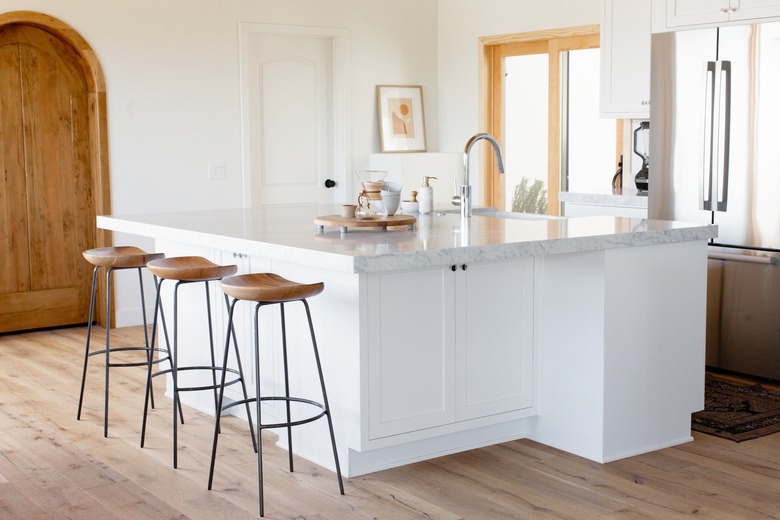What To Know Before Plumbing A Kitchen Island
We may receive a commission on purchases made from links.
Many homeowners like the idea of having a kitchen island, both for its aesthetic appeal and for the versatility of adding extra work space while adding more room for people to sit and gather in the kitchen. If you decide that you'd like to install a kitchen sink in your island, you face the challenge of plumbing services, and it really can be a challenge because plumbing a kitchen island sink is not as easy as installing a typical kitchen sink.
A kitchen sink vent pipe and sometimes the drain pipe are run inside the walls and hidden from view. Because there are no walls to hide the pipes with an island, everything needs to be installed within the island. This is not a problem with the drain and water pipes because they can be run up into the island through the floor. The real challenge with plumbing a kitchen island is the required venting to ensure the drain works properly.
The good news is that there are a couple of ways to vent an island sink that don't require running a vent straight up in the middle of your kitchen. If you feel confident enough to plumb a standard kitchen sink, you should be able to handle plumbing a kitchen island. It could save you anywhere from $400 to $1,500 in labor costs, so if you have the knowledge and the tools, it is worth doing at least some of the work yourself.
Using a Loop Vent for a Kitchen Island
Using a Loop Vent for a Kitchen Island
Along with providing a place for gas and odors to escape, a pipe vent supplies air to your drain system. Without air, your plumbing system will drain slowly or not at all. A vent also prevents the drain trap, or P-trap, from siphoning. A regular kitchen sink vent must rise at least 6 inches above the fixture before going horizontal. The vent pipe is hidden within the wall. Because a kitchen island doesn't have a wall to run a vent pipe, the vent must be contained within the cabinet.
The most common way to do this is by installing a loop vent. Like a vent for a typical kitchen sink, a loop vent connects to the trap arm, but instead of rising up through the wall, it rises as high as possible inside the island cabinet before dropping back down, where it goes through the floor and ultimately connects to the vertical vent. A cleanout should be installed in the vertical section of the loop vent in case there is a clog in the vent.
A loop vent will keep air in the system and prevent the P-trap from siphoning. The downside of a loop vent is that it takes up a lot of space in the cabinet, and it's possible that the vent will clog if a disposal is installed. This is why having an extra cleanout on a loop vent is very important. Using a straight tee for your cleanout will make it easier to snake out the top of a blocked loop vent. Because the vent is so important, you may want to have a plumber install a loop vent unless you are very comfortable with plumbing.
Venting Islands With Air-Admittance Valves
Venting Islands With Air-Admittance Valves
The other venting option when plumbing a kitchen island is an air-admittance valve (AAV). This is a gravity-operated valve that admits air when needed while blocking sewer gases. An AAV is usually installed as high as possible in the cabinet, although they can be installed as low as 4 inches above the trap. If an AAV is installed less than 4 inches above the trap, there is a risk of waste and debris becoming stuck in the internal diaphragm and preventing the valve from sealing properly.
Installing an AAV is far easier and more cost effective than running a loop vent because it does not require drilling an extra hole and tying into the existing vent. Unlike a loop vent, an AAV takes up very little space in your cabinet, which is particularly nice when space is already limited. The main drawback of an AAV is that it doesn't always work as well as a loop vent. They won't always keep up with the draining and venting needs of a large sink or dishwasher, which can result in slow drainage.
An AAV can also be used in other applications, such as with a regular kitchen sink, if for some reason it is not possible to run a proper vent pipe. A house cannot use only AAVs, however. At least one vent pipe must run to the outside of the house. AAVs are not approved for use in all areas, so before you install one, be sure to check with your local plumbing inspector to find out if your local code allows them.
Installing Water Connections
Installing Water Connections
While installing the drain plumbing for a kitchen island is the same as plumbing a regular sink, the venting system can cause some confusion and extra work. The good news is that installing the water supplies to your faucets is done in exactly the same way with an island sink as it is with a standard sink located adjacent to a wall. The only difference would be that a sink's water pipes will sometimes be stubbed out from the wall, and with an island sink, they always come up from the bottom of the cabinet.
To connect the water from the shutoff valve under the sink to the faucet, you can use a 1/2-inch x 3/8-inch compression valve or fitting. The easiest way is to use a SharkBite push-to-connect valve that you simply push onto your PEX or copper pipe. Then, you will connect flexible faucet supplies to the faucet stems and connect the other end to the 3/8-inch fitting. These supplies are usually made of braided stainless steel and are available in several lengths.
Using a supply that is a little too long is better than one that is too short because they are flexible enough to be bent and looped. If you install a dishwasher in your kitchen island, you can do so by installing a tee, a shutoff valve and a 3/8 compression fitting on the hot water pipe. Again, push-on fittings are the easiest way to do this. The dishwasher flexible water line will then be connected to the 3/8 fitting. The dishwasher drain hose connects to the garbage disposer or to the sink drain as with a standard sink configuration.


